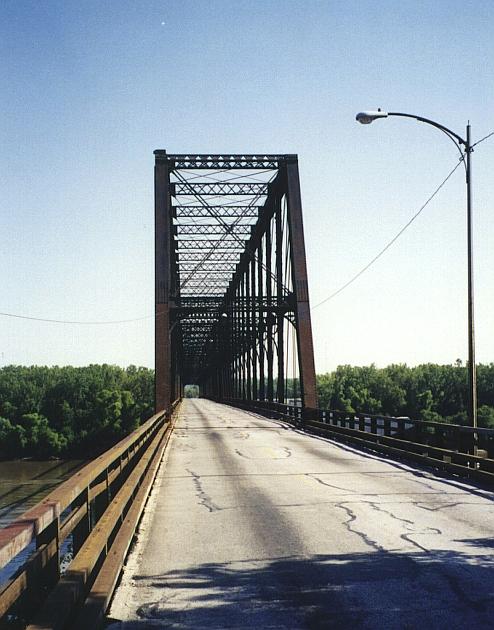
Built in 1887 as a railroad bridge, the former Chouteau Bridge across the Missouri River in Kansas City was converted for use by automobile traffic in 1951 and purchased by the Kansas City municipal government in 1953. In the bridge's later years, city engineers had long-standing concerns about the bridge's ability to stand up to traffic. As a result, there were frequent closures.
Just before I visited Kansas City on August 29, 1998 the bridge had been closed again two days before after some weakened supports were found.
The bridge re-opened later, but the closure presented an excellent opportunity to photograph what was the oldest highway bridge spanning the Missouri River in the state of Missouri.
The bridge was closed permanently on March 2, 2001. The steel girders below the deck of the bridge were still deteriorating. In addition, the city had a difficult time keeping heavy trucks off the bridge. The weight limit by that time was three tons. The new Chouteau Bridge opened in December 2001, shortly after the middle section of the old bridge was demolished.
This photograph of the old bridge was taken just beyond the barricades blocking traffic at the north end of the road. At the south end, the roadway continued into an industrial district of Kansas City.
A geographic note: Most of these photos were actually taken in North Kansas City, a separate municipality from Kansas City. The Chouteau Trafficway cuts through a small corner of North Kansas City between Missouri 210 and the river.
More photos of the old Chouteau Bridge and vicinity
- Orange Barrels
- Another photo of the closed bridge, also showing how narrow the roadway was. Notice the low weight limit.
- From the Deck
- A photo taken while standing on the deck of the bridge provides a view of the other end, plus a view of the pillars for the bridge that was to replace the Chouteau Bridge.
- Don't Go There!
- This sign was posted on Chouteau Trafficway near its interchange with Missouri 210. About a couple of miles of Chouteau Trafficway are still designated as Missouri 269, which once extended across the Chouteau Bridge and over city streets and the Manchester Trafficway to US 40 and Interstate 70.
- Don't Go There Again!
- This construction-style warning sign was also posted on the Chouteau Trafficway near the Missouri 210 interchange.
- In with the New
- A side view of the bridge, looking to the southwest, shows piers for a new span that replaced the Chouteau Bridge in December 2001. The replacement bridge was long sought by Kansas City's mayor and council as an alternate link between the fast-growing neighborhoods north of the Missouri and the traditional industrial area in the Blue Valley. More than 11,600 vehicles daily used the bridge, according to a report in the Kansas City Star on March 3, 2001.
- Other Views
- Some other photos of the old bridge:
- Harrington & Cortelyou (designer of the new bridge) (No longer shows old bridge; only shows new bridge)
- Implosion World (demolition of the old bridge)
The new four-lane bridge should help relieve traffic congestion on the major bridges serving the eastern part of the "Northland": the Paseo Bridge (carrying I-29, I-35, and US 71) and the I-435 bridge. A report in the Kansas City Star on December 18, 2001 cited a forecast of 26,000 vehicles using the bridge daily by 2010.
The middle section of the old bridge was demolished on December 5. The replacement bridge opened ahead of schedule on December 17, 2001.
Compare: photos of the new Chouteau Bridge
These photos were taken during a trip to Kansas City in September 2008. The rustic appearance of the neighborhood has changed a lot in ten years, due, for the most part, to the new, much wider highway.
- The New North End
- Looking at the north end of the new bridge, which is an expressway compared to the old bridge.
- Not Crossing the River on Route 269
- Missouri 269 has its southern endpoint at the Chouteau Bridge. In 1998, the end of the route was marked at a different location, at the Missouri 210 interchange. The end of the route was marked at the bridge in 2008.
- The New Bridge in Profile
- It's harder to get a profile view of the new bridge than before, but this view gives somewhat of a side view of the structure.
Denver, Colorado
E-mail: Please see the Contact Information page.